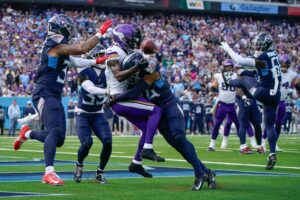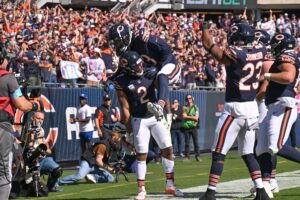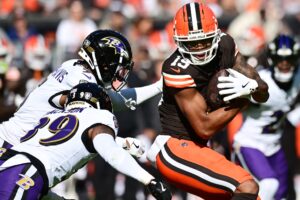Next in the NFC’s portion our newest series, “The Breakdown,” we take a look at the Chicago Bears schematic philosophy. Chicago surprised everyone when they gave Mike Glennon $45 million to be their starting quarterback, only to trade up a single spot in the NFL Draft and select North Carolina quarterback Mitch Trubisky just a month later. It remains to be seen what will become of their quarterback controversy, but let’s examine what the Bears do on both sides of the ball.
The Breakdown: A Look at the Chicago Bears Schematic Philosophy
From the Ground Up
First and foremost, the foundation of the Bears’ offense is built on their ground game comprised of a criminally underrated offensive line and a developing star in running back Jordan Howard. The mix of both outside and inside zone within the Bears’ system has become increasingly successful with an athletic unit that can work up to the second-level and secure double teams, allowing Howard to capitalize on his level of vision and instincts. Of course, it’s not unusual to see the Bears get Howard outside the tackles and along the perimeter.
The development of the zone running game is crucial in the foundation of how play-action passes are designed. Just look no further than the 2016 Atlanta Falcons. Should Trubisky become the starter, the use of an effective play-action game eases the transition and allows him to capitalize on both his athleticism and skills as a passer when on the move. Regardless of whether it’s him or Glennon, these move-the-pocket throws are adept at creating seamless catch-and-run opportunities for their weapons and offers valuable potential to generate offense. A strong zone running game and an equal play-action passing game can do immeasurable damage to a defense.
Chicago knew it needed a new quarterback, so they went out and acquired a handful of weapons, signing free agent receivers Markus Wheaton, Victor Cruz and Kendall Wright and drafting tight end Adam Shaheen and change-of-pace back Tarik Cohen. The jury is still out on 2015 first-rounder Kevin White, but fellow receiver Cameron Meredith really came into his own last season and rounds out a collection of offensive playmakers. Offensive coordinator Dowell Loggains operates from an 11 personnel base offense, but he doesn’t shy away from adding a running back or tight end so it will be interesting to see if he incorporates more four- and five-receiver looks. The offensive line is one of the NFL’s best and rarely requires extra help in pass protection.
The Veteran Coordinator
Vic Fangio guided an NFL defense from 1995-2005 before taking over as the San Francisco 49ers’ defensive coordinator in 2011 and taking over the reins in Chicago in 2014. He has become one of the most recognizable names in the NFL defensive community, and despite a down season in 2016, Fangio has the Bears ready to rock.
The established NFL coach has built his defense around a sound, well-disguised two-shell zone defense. This ultimately creates a natural reliance on four-man rushes and was the deciding factor behind taking edge rusher Leonard Floyd in the first round of the 2016 draft. In addition, Jonathan Bullard‘s development opposite Akiem Hicks is crucial to the team’s pass-rushing success. Blitz packages have to be precise and called at the appropriate times in a scheme like such, so these four-man rushes have to get home on a regular basis if they have any hope of generating equally-regular turnovers. Take, for example, Fangio’s 49ers leading the league with a whopping 35 turnovers in 2011.
In this base 3-4 unit, linebackers have to be athletic, free-flowing defenders who are capable of stopping the run and handling coverage duties. The defensive line is responsible for what’s known as “two-gapping” (controlling two gaps) to keep offensive linemen off the linebackers to allow them to make plays, so the 2016 additions of Jerrell Freeman and Danny Trevathan should come as no surprise. Possessing these types of athletes at such level of the defense is an integral part of the disguise and flexibility portion of the pass rush, but they must also be quality run defenders if they wish to capitalize on the clearly-defined running lanes they must attack. That’s essentially where the Bears saw themselves land in trouble, struggling to properly maintain their run fits and prevent the extension of runs.
It’s an uphill battle for the Bears no matter who earns the starting nod at quarterback, but they have the blend of talent and youth to build a potential winner. Expect to see Trubisky in action by mid-October as the Bears work their way to another top ten pick.






